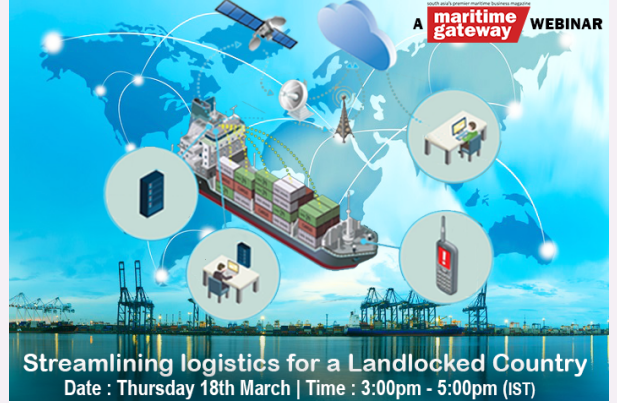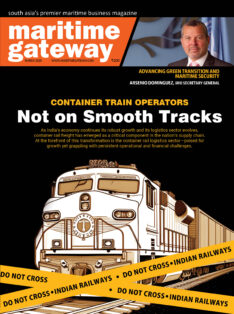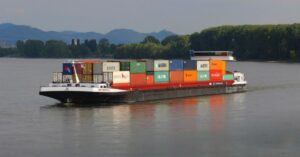Logistics issues for a landlocked country like Nepal are rather different as it is dependent on neighbouring countries’ infrastructure for transhipment of its cargo. Here the issues of high logistics cost, visibility across the supply chain and traceability of cargo emerge. Addressing exactly these concerns NICDC Logistics Data Services (NLDS), in collaboration with Maritime Gateway organised the Webinar titled “Streamlining logistics for a landlocked country.”
Setting the tone for deliberations that were going to happen over the next two hours, Ramprasad, Editor-in-Chief, Maritime Gateway, recalled how COVID-19 has impacted our businesses and social lives. Apart from everything else, digitalisation has received a massive push during these times of distress. But NLDS has been surging ahead with its digital initiatives long before the pandemic had set-in, in order to enable visibility and traceability of cargo. It helps in identifying the dark spots in logistics and improve the lead time, turnaround time, enables managers to plan logistics better, which also happen to be the pain-points for Nepal trade.
Dipak Kumar Gupta, Secretary, Land Ports Authority of India (LPAI), emphasised on the need to convert Land Customs Stations (LCS) into Integrated Check Posts (ICPs) and create sufficient infrastructure for all stakeholders. This can help the Indo-Nepal trade to grow manifold, which is currently pegged at Rs.30,000 Cr annually. He suggested that container movement needs to start at ICPs and work is in progress for providing rail sidings there. The LCS at Raxaul is being converted into ICP and two more ICPs are coming up at Sunauli and Rupaidiha.
Naresh Kumar Agrawal, Vice President, Nepal Freight Forwarders Association (NEFFA), brought to the fore key issues: the import/export ratio of Nepal trade is skewed at 16:1, of which, 60% moves through Kolkata Port and the remaining through Vizag Port. Nepal has further requested for access to Dhamra and Mundra ports. Plans are also in progress for using inland waterways. Shipping lines are providing services at ICDs but not at ICPs. The logistics cost for Nepal is also too high at 25% to 30%.
Surajit Sarkar, Chief Operating Officer, NICDC Logistics Data Services Limited, gave an intro into the establishment and functioning of NLDS. The tracking service is functional at all container terminals in India, four check posts on Nepal border, 50 toll plazas, 162 CFS/ICDs. So far more than 32 million containers have been tracked. He detailed on the container tracking process using RFID tags and the dark spots in the supply chain that can be checked using this tracking process. NLDS is currently functional at Agartala, Petrapole, Jogbani and Raxaul. NLDS is also in the process of integrating with the e-sealing process of Customs.
Abhay Kumar Mohapatra, General Manager (Traffic), Syama Prasad Mookerjee Port Trust, gave an intro into the infrastructure and functioning at his port. The port has a cargo handling capacity of 97.9MT (KDS – 27.3MT & HDC – 70.6MT). Being a riverine port it has a 232km long navigational channel and connects to NW – 1,2&5. The port handled 46.3 million tonnes of cargo in 2014-15, which increased to 64 million tonnes in 2019-20. Detailing on the facilities offered to Nepal cargo he said, 10% rebate is offered on all boxes to Nepal, 20 days of free storage time is offered for rail bound cargo, 50% discount is offered on terminal and haulage charges. Last year during lockdown, port storage charges were also waived from March to May. While Nepal receives cargo from multiple ports the country has only one release point for rakes which causes congestion. NLDS in collaboration with Syama Prasad Mookerjee Port Trust started container tracking service in 2016.
Mohan Bandaru, President – Commercial & Operations, Indomatrix Logistics Pvt Ltd (Pristine Group), pointed out that when dry port operations were started in 2005 they handled 500 containers per month, which increased to 4500 containers per month today. Taking a note of logistics glitches he said, Nepal is just 700km from Kolkata but trucks take 7 days for the journey due to poor road conditions. If proper roads are developed truck transit time can be reduced to 3 days. Another concern is the prevalence of physical documentation which needs to be replaced by digital processes.
Kamal Somani, Director, Inland World Logistics Pvt Ltd, detailed on the B2B services offered by their group not only for Nepal but also other member countries of BBIN. They move more than 1000 teus per month in bilateral trade for Nepal. In this process they have a vision of reducing the turnaround time for Nepal cargo, for which IWL is partnering with NLDS.
Detailed discussions and presentations by panel members were followed by Q&A session wherein inquisitive audience asked several queries related to sealing of containers, tracking details with respect to location and logistics cost. Towards the conclusion Mr. Ramprasad summed up the discussions as follows:
- Both India and Nepal governments are proactive in improving trade efficiency.
- Transparency and data security are major issues when it comes to tracking of cargo.
- Seamless movement of cargo with reduced logistics cost is the need of the hour.












